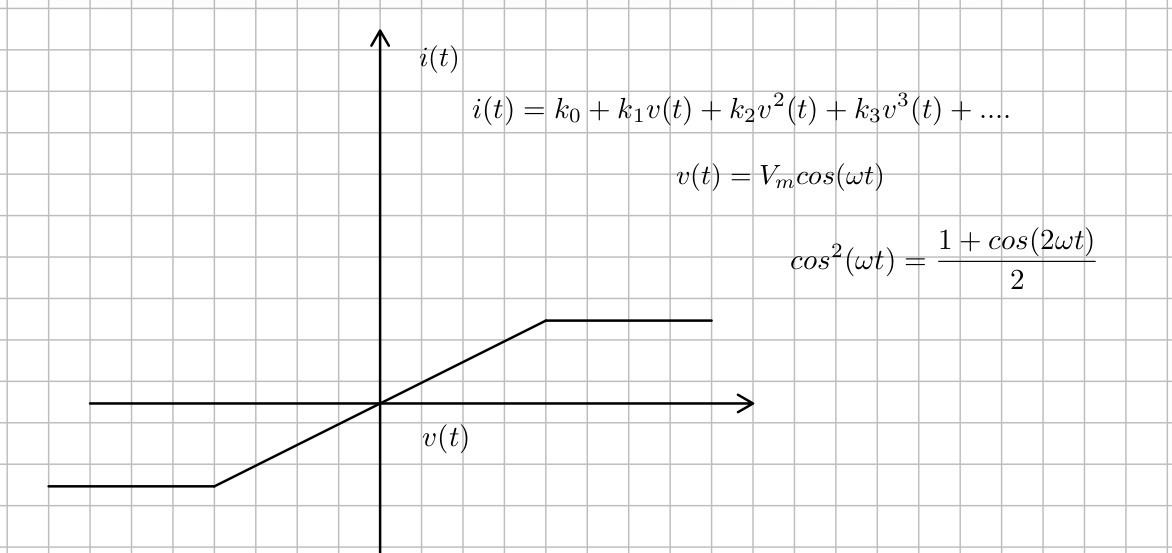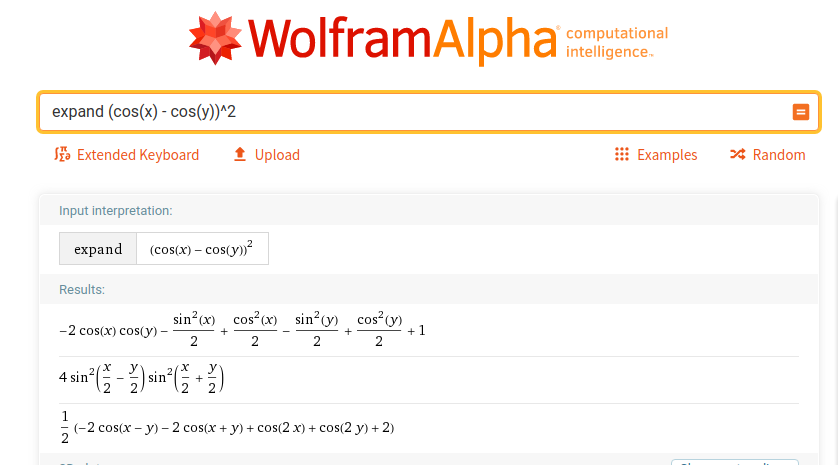Distortion Caused by a Non-Linnear Amplifier or Circuit¶
If $v(t) = V_m cos(\omega t)$, then then because we have a non-linear impedance, $i(t) = \sum c_n cos(n \omega t + \phi_n)$. The cause of harmonics can be seen if we take a simple I-V curve that has clipping for the current. You can write the current as a power series (using Taylor's work), and from that you can see how it is the same as a Fourier series with harmonics caused by the clipping. The resulting waveform is periodic, but now has frequency components at $n\omega$.  This is the same whether the output is the current or a larger voltage, such as with an amplifier. When you expand a term like $cos^n(\omega t)$ you get a linear combination of terms containing $cos(m\omega t)$ where $m \le n$. For example, the trig identity you use to integrate $cos^2(\omega t)$ is $cos^2(\omega t) = (1+cos(2\omega t))/2$. There is a useful more general trig identity you can derive using Euler's identity: $$cos(a) cos(b) = \frac{cos(a+b) + cos(a-b)}{2}$$
This is the same whether the output is the current or a larger voltage, such as with an amplifier. When you expand a term like $cos^n(\omega t)$ you get a linear combination of terms containing $cos(m\omega t)$ where $m \le n$. For example, the trig identity you use to integrate $cos^2(\omega t)$ is $cos^2(\omega t) = (1+cos(2\omega t))/2$. There is a useful more general trig identity you can derive using Euler's identity: $$cos(a) cos(b) = \frac{cos(a+b) + cos(a-b)}{2}$$
If we use this, we can see that $$cos^3(\omega t) = \frac{1 + cos(2\omega t)}{2} cos(\omega t) = \frac{2cos(\omega t) + cos(3\omega t) +cos(\omega t)}{4} = \frac{cos(3\omega t) +3cos(\omega t)}{4}$$ So, in summary, a nonlinear circuit element causes distortion, because the Taylor series describing it has terms higher than first order, and when the input is $cos(\omega t)$ the Taylor series becomes a Fourier series made up of DC, the fundamental frequency signal, and all the harmonic signals. Thus the nonlinear circuit has harmonic distortion, because the output is not proportional to the input.
Intermodulation Distortion¶
Suppose $v(t)$ in the example above was the difference between two frequencies, $v(t) = cos(\omega_1 t) - cos(\omega_2 t)$. Then using Wolfram Alpha's result for $(cos(x)-cos(y))^3$ below: 
we can see the frequencies we will get include $\omega_1 - \omega_2, \omega_1+\omega_2, 2\omega_1, 2\omega_2$, and DC. In general, the terms of the whole Taylor series have frequencies $\pm (n \omega_1 \pm m \omega_2)$. Here you have to remember that a negative frequency sinusoid is still a sinusoid of the positive frequency, because $sin(-x) = -sin(x)$ and $cos(-x) = cos(x)$.
In a receiver that receives a small range of frequencies, third order intermodulation distortion (IMD) products whose frequencies are $2\omega_1 - \omega2$ and $2\omega_2 - \omega_1$ can be problematic, because the original signals at $\omega_1$ and $\omega_2$ pass through the RF filter, and so can be large. When they run into a nonlinear component, they create a signals at $2\omega_1 - \omega2$ and $2\omega_2 - \omega_1$ that really are not there at the antenna input to the receiver. What other IMD products might also be troublesome in a receiver?